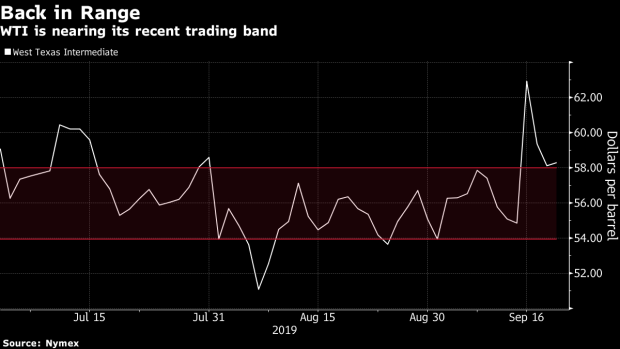Sep 18, 2019
Oil Steadies as Saudis Pledge Swift Return of Lost Production
, Bloomberg News

(Bloomberg) -- Oil held its decline from the dramatic spike earlier in the week as supply assurances from Saudi Arabia and the International Energy Agency calmed the market after the devastating weekend attacks.
Futures in New York were little changed after paring around half of Monday’s 15% surge over the last two days. The damaged Abqaiq oil facility is now operating at around 40% of its pre-attack levels and output should be fully restored by the end of the month, according to Saudi Aramco Chief Executive Officer Amin Nasser. Meanwhile, IEA Executive Director Fatih Birol said the global oil market remains well supplied with ample stockpiles.
Concern over potential retaliatory action from Saudi Arabia and the U.S. is keeping the market on edge. The kingdom said the attacks, which took out 5% of global oil production, were unquestionably sponsored by Iran and did not originate from Yemen. President Donald Trump said the U.S. will add “some very significant sanctions” and announce them within the next 48 hours.
Iranian President Hassan Rouhani has denied responsibility for the strike, saying it was carried out by Yemeni rebels fighting the Saudi-led coalition.
“Middle East risks remain elevated and the Iranian issue is not going away,” said Michael McCarthy, chief markets strategist at CMC Markets Asia Pacific Pty in Sydney. However, the markets are settling down to a more fundamental, balanced view around the demand-supply scenarios, he said.
The IEA’s Birol said its members held about 1.55 billion barrels of emergency crude stocks, more than enough to offset any disruption. The global oil market has enough resources to balance a large supply outage without requiring a strategic petroleum reserve release by developed nations, Goldman Sachs Group Inc. said in a note.
West Texas Intermediate crude for October delivery rose 8 cents, or 0.1%, to $58.19 a barrel on the New York Mercantile Exchange as of 10:09 a.m. in Singapore. It dropped 2.1% Wednesday following a 5.7% decline on Tuesday.
Brent for November settlement added 6 cents to$63.66 a barrel on the ICE Futures Europe Exchange after falling 1.5% on Wednesday. The global benchmark crude was trading at a $5.51 premium to WTI for the same month.
An Energy Information Administration report showed U.S. oil inventories rose by 1.06 million barrels last week. That was almost double what the American Petroleum Institute reported Tuesday and compared with analyst forecasts for a 2.25 million barrel decline. Gasoline stockpiles increased 781,000 barrels, while distillate supplies climbed 437,000 barrels, the EIA said.
--With assistance from Alexander Kwiatkowski.
To contact the reporters on this story: Saket Sundria in Singapore at ssundria@bloomberg.net;James Thornhill in Sydney at jthornhill3@bloomberg.net
To contact the editors responsible for this story: Serene Cheong at scheong20@bloomberg.net, Andrew Janes, Ben Sharples
©2019 Bloomberg L.P.


